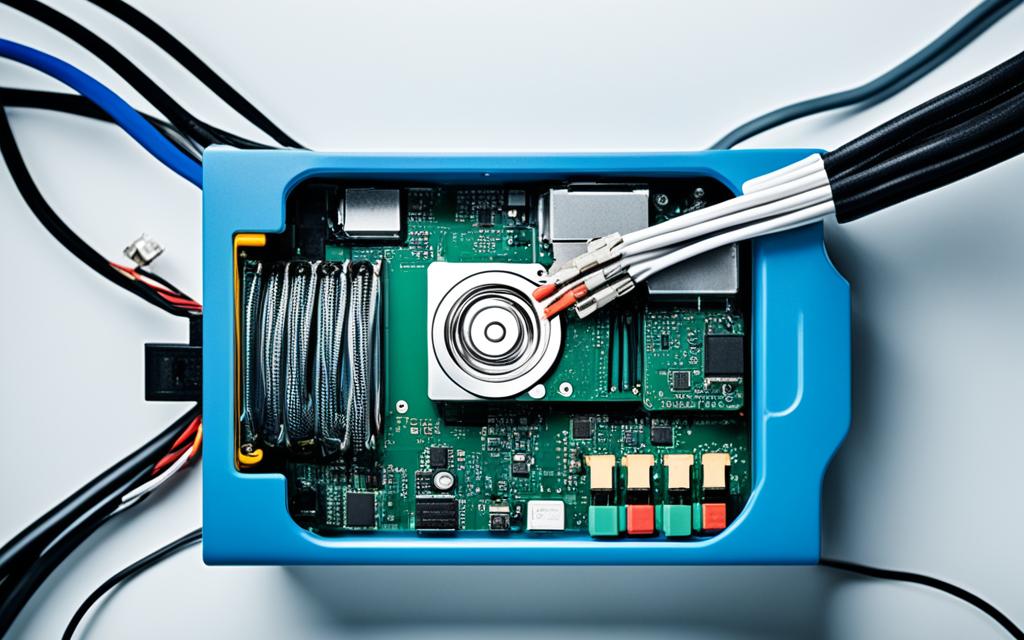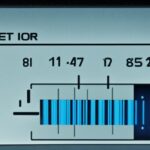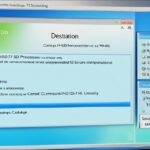Table of Contents
When your HDD isn’t detected, it can be really frustrating. But, there’s hope for getting back your important files. There are lots of methods to recover your data. Knowing what to do is key when your hard drive has issues, but usually, you can get your data back. This guide will show you how to deal with this issue calmly and effectively. If facing troubles, software like Stellar Phoenix Data Recovery, EaseUS Data Recovery Wizard, and Disk Drill can help. They offer a chance to recover lost data. Let’s explore various recovery techniques1.
Key Takeaways
- Understanding the signs of a non-detecting HDD can save time and effort in data recovery.
- Common causes for the issue may range from hardware damage to software errors.
- Utilising appropriate data recovery software can enhance the chances of a successful recovery.
- Regularly backing up data is crucial to mitigate the impact of potential hard drive failures.
- When in doubt, seeking professional data recovery services can provide the best chance for retrieval.
Understanding Hard Drive Detection Issues
Identifying hard drive detection problems is key to fixing them efficiently. If your hard drive is not detected, it can interrupt your daily activities and cause a lot of data to be lost. Recognising the symptoms that suggest a hard drive may be failing is critical for diagnosing and planning how to recover from such a situation.
Common Symptoms of a Non-Detecting Hard Drive
Various symptoms can signal that there’s a problem with your hard drive being detected. Here are some common clues:
- Error messages such as “Drive not formatted.”
- Messages that say “Access is denied.”
- The drive not responding when connected to a computer.
- The hard drive is missing from system directories.
These signs usually come from different causes, like hardware issues or driver problems. These issues can affect how your hard disk drive (HDD) works.
Potential Causes Behind Hard Drive Detection Problems
It’s important to know why a hard drive might not be detected. Common reasons include:
- Problems with the hardware, like a faulty USB port or data cable.
- Drivers for the hard disks being out of date or corrupted.
- File systems on the hard drive being damaged or corrupted.
- Physical damage to the hard drive due to power problems or overheating.
Other factors that might cause detection problems include BIOS settings, poor connections, and old drives. For example, the hard drive may not be turned on in the BIOS or the Serial ATA drivers could be wrongly installed, which affects the hard drive’s detection2. Solurança these issues can greatly improve your chances of getting the hard drive to work again.
How to Recover Data from HDD Which is Not Detecting
Trying to get back data from a hard drive that won’t appear might seem tricky. Yet, with the right data recovery software, you’re on a good path. These tools are crafted to tackle logical errors brilliantly. They suit different recovery scenarios.
Utilising Data Recovery Programmes
There are many choices when it comes to data recovery programmes. Names like EaseUS Data Recovery Wizard and Stellar Phoenix stand out. These apps are built to look for lost files with ease. They’re easy for anyone to use, without needing an expert. If you buy one, you can usually test it first and make sure it meets your needs.
Steps for Using Data Recovery Tools
The steps to use these tools are easy:
- Download and Install: Pick a reputable data recovery software and install it by the book.
- Scan the Drive: Open the programme and choose the hard drive that’s not showing. The scan should look for all files, lost and present.
- Preview and Recover: After the scan, look at what’s been found. Pick what you need saved. Follow the steps to save these files in a new spot.
Seeking more help with a hard drive that won’t show? Guides on hard drive recovery are very useful. They provide deeper steps and help solve common issues. With solid software and a good plan, recovering your files is more than possible.
Physical Issues and Their Solutions
When a hard drive gets damaged, it might be because of physical harm, risking important data loss. Knowing the signs of physical damage is key to get help in time. It’s important for people to notice these symptoms to call for expert recovery help.
Signs of Physical Damage to the Hard Drive
Physical issues often show up as strange sounds. For example, clicking or grinding noises suggest hard drive failure. The hard disk parts might wear out or not be made right. This makes data hard to get and can cause big problems.
- Clicking or grinding sounds from the drive
- Frequent system crashes or inability to boot
- Visible damage to the external casing
- Overheating during use
When to Seek Professional Data Recovery Services
Seeing any signs mentioned before means it’s time to look for professional recovery help. Trying to get data back yourself can make things worse, leading to permanent data loss. Companies like EaseUS deal with these issues, improving disk performance and getting data off broken drives. Using tools from the maker to keep an eye on the hard drive helps prevent big data losses when damage happens.
Expert help is needed when basic steps don’t work. Keeping data safe and sound is crucial for everyone34.
Preventive Measures for Data Loss
In today’s world, keeping data safe is more important than ever. Making sure we have effective ways to stop data loss is key. With hard drives likely to fail within three years, regular backups are a must5. By setting up a good data management plan, you can keep your data safe and get it back quickly if it’s lost.
Regular Back-ups and Data Management
Keeping up with regular backups is crucial for stopping data loss. It’s a good idea to update things like disk drives every few years to avoid surprises5. A strong backup plan uses both local and cloud options to make sure you’re covered if one fails. Deciding how often to backup, based on your recovery needs, is essential to avoid big problems5.
Here’s a quick look at the different ways to backup data:
| Backup Type | Description | Pros | Cons |
|---|---|---|---|
| Local Backup | Backing up data to an external hard drive or network storage. | Fast recovery times, full control over data. | Risk of physical damage or theft. |
| Cloud Backup | Storing data on off-site servers accessed via the internet. | Accessibility from anywhere, protection from local disasters. | Potential subscription fees, dependency on internet connectivity. |
| Hybrid Backup | Combining local and cloud backup methods. | Offers the benefits of both local and remote access. | Complex setup, requires management of both solutions. |
Monitoring Hard Drive Health with S.M.A.R.T. Data
It’s vital to watch the health of hard drives to prevent data loss. These drives use motors to spin disks fast, which wears out over time6. Using S.M.A.R.T. data tools lets us see possible issues early. By looking for signs of trouble, we can change parts before they fail. Knowing common ways data can be lost helps us keep things running smoothly56.
Conclusion
Dealing with HDD problems can seem scary. However, knowing your options makes the fix more achievable. There are different ways to get back lost or hard-to-reach data. Using trusted software like Disk Drill is one route. Or, for tough physical damage, expert services are needed. Physical issues can make hard drives not work if their parts are out of place or scratched. Logical errors, like those from harmful software or not safely removing the drive, can also cause loss of data78.
It’s also key to prevent problems before they happen. Backing up data regularly and keeping an eye on your hard drive’s health helps keep your data safe. Common troubles include accidentally deleting files or formatting. Thankfully, certain software can bring back these files if no new data has replaced them8. Noticing early signs of hard drive failure can reduce worry and make your data more secure.
By being proactive with your data management, you underline the value of dependability and careful monitoring. Adopting these practices means you control your data’s fate. This lowers the risk of losing data and improves your chances of getting it back if HDD issues do occur7.
FAQ
What should I do if my hard drive is not detecting?
Remain calm if your hard drive isn’t detected. First, check all connections. Then, restart your computer. Try accessing the drive from another device. If these steps don’t work, look into data recovery software or get professional help.
What are the common symptoms of a non-detecting hard drive?
You might see error messages like “Drive not formatted” or “Access is denied”. You could also hear odd noises. These signs suggest problems needing immediate attention for data recovery.
How can I recover data using software?
Start by downloading a reliable data recovery tool. EaseUS Data Recovery Wizard or Stellar Phoenix are good choices. Follow the instructions to scan for and restore needed files.
What types of physical damage might my hard drive have?
Physical damage often sounds like clicking or grinding. These noises suggest serious issues, like head crashes or platter damage. In these cases, see a professional to prevent more harm.
When should I consider professional data recovery services?
Consider professional help if your drive makes strange noises or if software couldn’t fix the issue. Specialists have the right tools and know-how for serious damage.
What preventive measures can I take to avoid data loss?
Always back up your data, using both local and cloud options. Use S.M.A.R.T. data to keep an eye on your drive’s health. This can help you avoid sudden failures.
How often should I back up my data?
Backing up data regularly is key. How often depends on how much you use your files. Daily, weekly, or monthly backups can protect you from unexpected loss.
Source Links
- https://www.linkedin.com/pulse/how-recover-data-from-failed-hard-drive – How to Recover Data from a Failed Hard Drive: A Comprehensive Guide
- https://www.easeus.com/data-recovery/recover-not-recognized-external-hard-drive-data.html – How to Recover Data from Hard Disk Which Is Not Detecting Easily
- https://www.gillware.com/hard-drive-data-recovery/hard-drive-not-showing-up/ – Hard Drive Not Showing Up: Recovering HDD Not Detected
- https://www.easeus.com/data-recovery/recover-data-from-dead-hard-drive.html – How to Recover Data from Damaged Hard Drive | with Tips
- https://invenioit.com/continuity/prevent-data-loss-from-hardware-failure/ – 8 Ways to Prevent Data Loss From Hardware Failures
- https://www.ninjaone.com/blog/hard-drive-data-recovery-how-to-recover-data-from-a-dead-hard-drive/ – Hard Drive Data Recovery: How to Recover Data From a Dead Hard Drive | NinjaOne
- https://www.cleverfiles.com/howto/dead-hard-drive-recovery.html – How to Recover Data from a Dead or Damaged Hard Drive (2024)
- https://www.linkedin.com/pulse/recover-data-from-external-hard-drive-handy-recovery-xmtzf – How to Recover Data from an External Hard Drive and Protect Your Files in the Future








